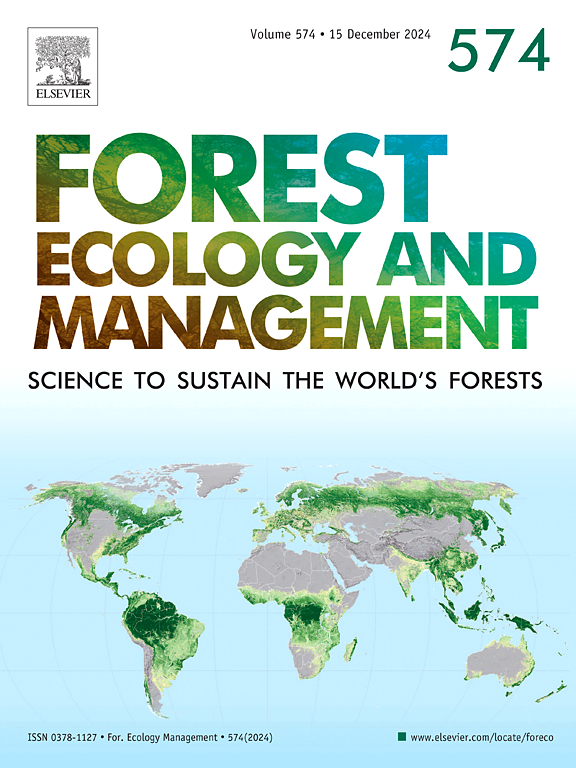Long-term soil nutrient and understory plant responses to post-fire rehabilitation in a lodgepole pine forest
IF 3.7
2区 农林科学
Q1 FORESTRY
引用次数: 0
Abstract
Wildfires and other disturbances play a fundamental role in regenerating lodgepole pine forests. Though severe, stand-replacing fires are typical of this ecosystem, they can have dramatic impacts on soil properties and biogeochemical processes that influence the rate and composition of vegetation recovery. Organic soil amendments are often applied to manage post-fire erosion, but they can also improve soil moisture and nutrient retention and potentially alter the trajectory of post-fire revegetation. We compared change in soil nutrients, microbial communities, and understory plant cover and composition on six burned hillslopes treated with 1) biochar (20 t ha −1), 2) wood mulch (37 t ha−1), 2) biochar + mulch, and 4) an untreated control a decade after the 2010 Church’s Park fire. Wood mulch increased soil moisture and N retention the first three years following treatment. Mulch and biochar were still visible when we resampled in 2023. Mulch continued to increase soil moisture compared to unamended controls, though it had few lasting effects on soil N or cations. Conversely, biochar added alone increased dissolved organic C in soil leachate, C:N in soil and leachate, and hosted microbial communities distinct from those in mulch and combined biochar and mulch treatments. Biochar also elevated various dissolved and extractable soil N forms but reduced net nitrification. The amendments had no general effect on total graminoid, forb, or shrub cover, but had plant species-specific impacts. For example, biochar doubled cover of the dominant shrub Vaccinium scoparium, and mulch reduced cover of the most common forb (Oreochrysum parryi) by more than 50 %. The combined biochar and mulch treatment had persistent, additive effects on both soil and plant responses that exceeded impacts of the individual treatments. As seen increasingly in western North America, conifer regeneration remains scarce in the Church’s Park burn scar, and these findings suggest that mulch and biochar amendments may improve reforestation success following severe wildfires.
在一片落叶松林中,土壤养分和林下植物对火灾后恢复的长期反应
野火和其他干扰对落羽松森林的再生起着至关重要的作用。虽然严重的森林火灾是这一生态系统的典型特征,但它们会对土壤特性和生物地球化学过程产生巨大影响,从而影响植被恢复的速度和组成。有机土壤改良剂通常用于控制火灾后的水土流失,但它们也能改善土壤水分和养分的保持,并有可能改变火灾后植被重建的轨迹。2010 年 Church's Park 大火发生十年后,我们比较了六个烧毁山坡上土壤养分、微生物群落、林下植物覆盖率和组成的变化,这些山坡分别使用了 1) 生物炭(20 吨/公顷-1)、2) 木质覆盖物(37 吨/公顷-1)、2) 生物炭 + 覆盖物和 4) 未经处理的对照组。在处理后的头三年,木质覆盖物增加了土壤水分和氮的保持率。我们在 2023 年重新取样时,仍能看到覆盖物和生物炭。与未添加覆盖物的对照组相比,覆盖物继续增加土壤湿度,但对土壤氮或阳离子的持久影响很小。相反,单独添加的生物炭增加了土壤沥滤液中的溶解有机碳、土壤和沥滤液中的碳氮比,并产生了不同于覆盖物和生物炭与覆盖物组合处理的微生物群落。生物炭还提高了土壤中各种溶解氮和可萃取氮的含量,但降低了净硝化作用。这些改良剂对禾本科植物、禁止植物或灌木的总覆盖率没有普遍影响,但对特定植物物种有影响。例如,生物炭使主要灌木 Vaccinium scoparium 的覆盖率提高了一倍,而覆盖物则使最常见的禁草(Oreochrysum parryi)的覆盖率降低了 50% 以上。生物炭和覆盖物的综合处理对土壤和植物的反应具有持续的叠加效应,超过了单独处理的影响。正如在北美西部越来越多地看到的那样,Church's Park 烧伤疤痕中针叶林的再生仍然稀少,这些研究结果表明,覆盖物和生物炭添加剂可以提高严重野火后重新造林的成功率。
本文章由计算机程序翻译,如有差异,请以英文原文为准。
求助全文
约1分钟内获得全文
求助全文
来源期刊

Forest Ecology and Management
农林科学-林学
CiteScore
7.50
自引率
10.80%
发文量
665
审稿时长
39 days
期刊介绍:
Forest Ecology and Management publishes scientific articles linking forest ecology with forest management, focusing on the application of biological, ecological and social knowledge to the management and conservation of plantations and natural forests. The scope of the journal includes all forest ecosystems of the world.
A peer-review process ensures the quality and international interest of the manuscripts accepted for publication. The journal encourages communication between scientists in disparate fields who share a common interest in ecology and forest management, bridging the gap between research workers and forest managers.
We encourage submission of papers that will have the strongest interest and value to the Journal''s international readership. Some key features of papers with strong interest include:
1. Clear connections between the ecology and management of forests;
2. Novel ideas or approaches to important challenges in forest ecology and management;
3. Studies that address a population of interest beyond the scale of single research sites, Three key points in the design of forest experiments, Forest Ecology and Management 255 (2008) 2022-2023);
4. Review Articles on timely, important topics. Authors are welcome to contact one of the editors to discuss the suitability of a potential review manuscript.
The Journal encourages proposals for special issues examining important areas of forest ecology and management. Potential guest editors should contact any of the Editors to begin discussions about topics, potential papers, and other details.
 求助内容:
求助内容: 应助结果提醒方式:
应助结果提醒方式:


